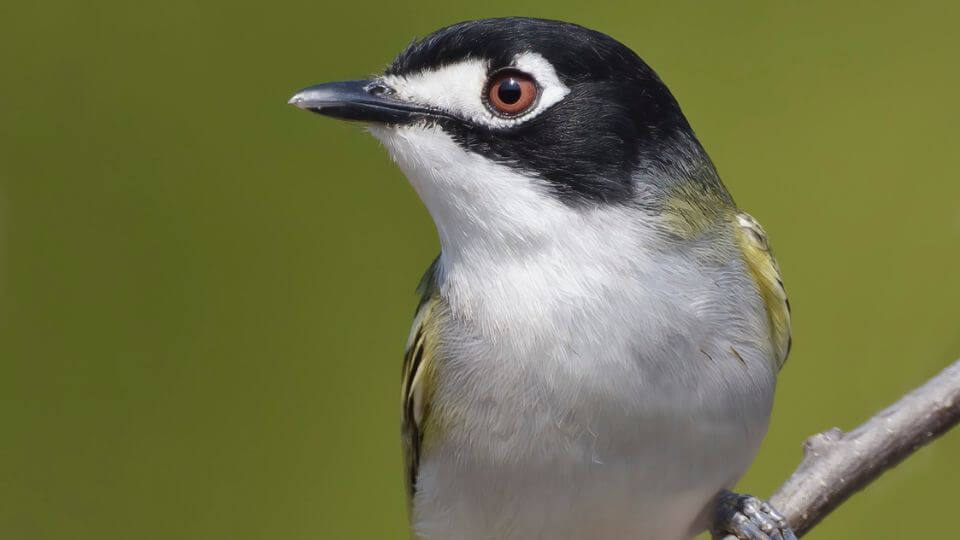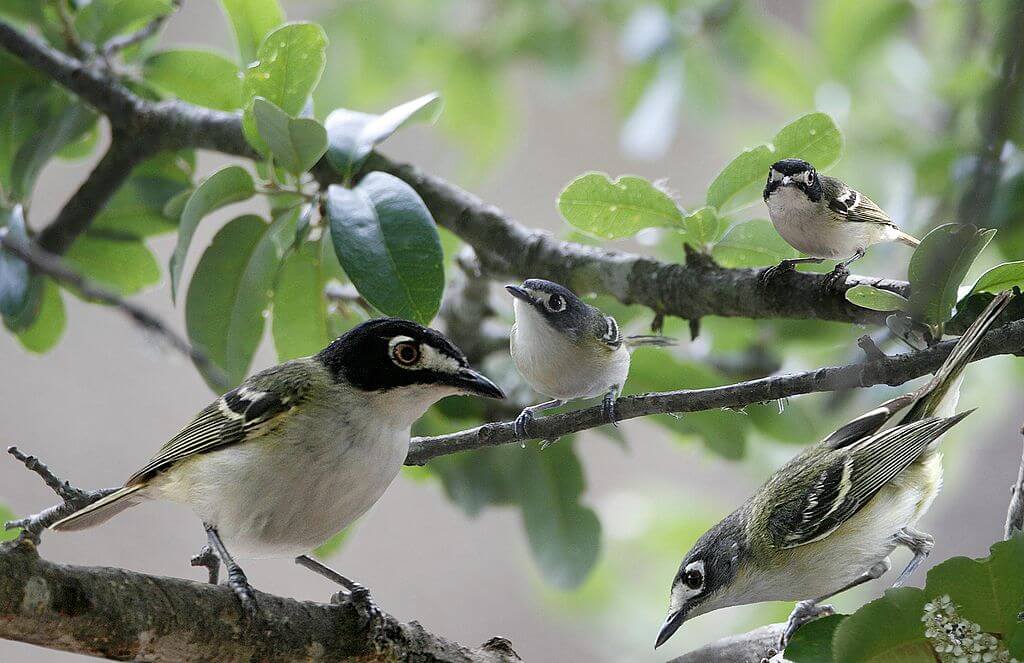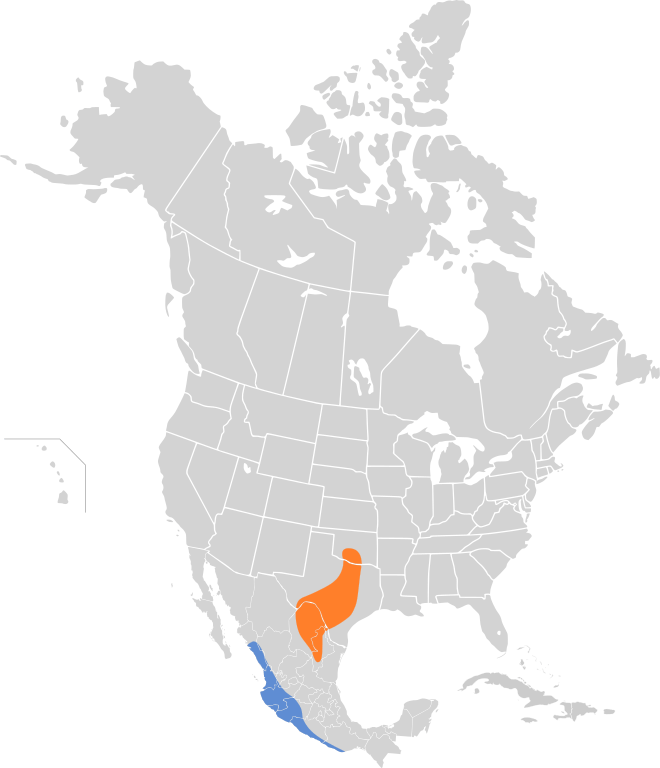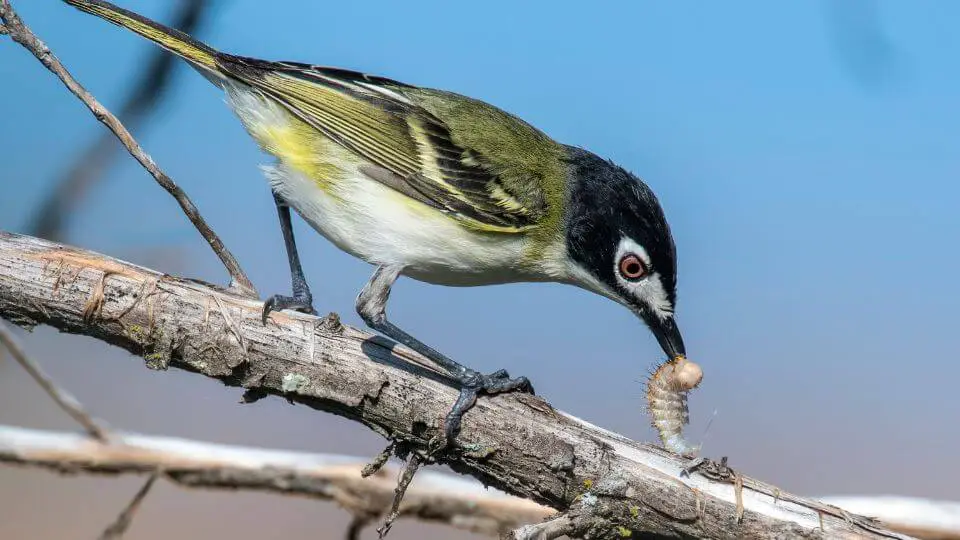Black-capped vireos are bush dwelling birds that build their nests in the thickets of woody scrub oak plants known as shinneries. Their population is condensed in a small area of Texas, and they migrate a short distance to Mexico during the winter season.
With piercing red eyes, various songs that change throughout the day, and secretive nature, the black-capped vireos are a must-see for birdwatchers!
What Does a Black-Capped Vireo Look Like?
The black-capped vireo, or Vireo atricapilla, is a tiny bird about the size of a house sparrow or a chickadee. It belongs to the family of Passeriformes family similar to warblers or sparrows. However, unlike the house sparrow, the habitat range of the black-capped vireo is petite and only breeds in a small portion of the United States.
Black-capped vireos can be identified by their olive green and yellow coloring, white spectacles around their eyes, and greenish-yellow underparts.

Females vs. Males
As with most songbirds, the male black-capped vireo has striking yellow feathers while the female does not. The male black-capped vireo is easy to spot with bright yellow plumage that stands in stark contrast against its black head.
Female black-capped vireos, on the other hand, don’t have the bold colors of the male. They don’t even have black caps!
Instead, females have a gray head with olive green feathers on their underparts and wing bars.
What do males and females have in common? They boast the same pair of white spectacles around their stunning red eyes.

Where Can I Find Black-Capped Vireos?
Spotting a black-capped vireo is rare because their habitat and range of migration are small.
Here are some key areas where you can find the black-capped vireo:
- Texas: Texas is a significant stronghold for the black-capped vireo. It can be found in parts of central and western Texas, including the Edwards Plateau, the Hill Country, and areas in the western portion of the state.
- Oklahoma: The songbird is also present in parts of Oklahoma, particularly in the southern and western parts of the state.
- Northern Mexico: The species has a limited distribution in the northern states of Mexico, such as Coahuila and Nuevo León, adjacent to the Texas border.

Black-capped vireos prefer to inhabit arid regions with dense shrublands or brushy areas, commonly found in oak-juniper woodlands, scrubby grasslands, and mixed brush habitats. They are often associated with areas containing Ashe juniper, Texas oak (also known as scrub oak) and other low shrubs and trees.
What Does a Black-Capped Vireo Eat?
Black-capped vireos live on a diet of seeds and insets. During the summer months in the breeding season, most of their diets consist of caterpillars, larvae, and other insects plucked from the leaves of bushes and thickets.
During non-breeding months, the black capped vireo eats primarily seeds and nuts from native plants in Central America.

What About Mating, Nesting, and Eggs?
The black-capped vireo sings not only to attract a mate but also to establish dominance over its territory. Vireos are intensely territorial birds, and flocks of black-capped vireos often return to the same nesting site during the breeding season.
Unlike other songbirds, the adult male and female work together to construct their nest. black-capped vireo nests comprise bark, grass, spider webs, and other leafy materials.
If you want to spot a vireo nest – look down! Vireos build nests close to the ground in dense thickets and rarely build nests higher than six feet off the ground.
When the nest is completed, the female lays three to four eggs per clutch. After incubation, the male vireo often feeds and cares for nestlings and fledglings as the female leaves to lay her second (and last) clutch of the season.
Hatchlings, Fledglings, and Juvenile Black-Capped Vireo Birds
After the eggs hatch, the male vireo is responsible for raising and feeding its young birds while the female hunts down another mate. These young birds live on a diet of mostly insects and larvae and continue to follow the male parent well after they leave the nest.
At a glance, it’s difficult to tell the difference between a juvenile vireo and a female black-capped vireo. Both birds have very similar muted coloring, and males don’t achieve their bright yellow plumage until they reach adulthood.
Vocal Repertoire: Songs, Calls, and Sounds
More often than not, you may hear a blacked-capped vireo but never spot it. They hide in thick brush and have loud and rapid vibrating trills to defend their territory and attract a mate.
Their songs are often heard early in the breeding season and diminish as the season ends. To communicate with other vireos or warn of danger, the jidit call is heard year-round.
If they are particularly agitated, they snap their beaks to intimidate nearby predators or other birds trespassing in their fiercely-guarded territory.
Is The Black-Capped Vireo Endangered?
The black-capped vireo was listed as “endangered”, but it was removed from the list in 2018. In the 1960s, their numbers fell significantly due to brood parasitism of the Cowbird, deforestation, brush control, wildfires, and urbanization.
Luckily, with great effort by the U.S. Army in Fort Hood, the numbers of black-capped vireos continue to climb. While they haven’t crossed over into bird species of least concern, they are well on their way!

